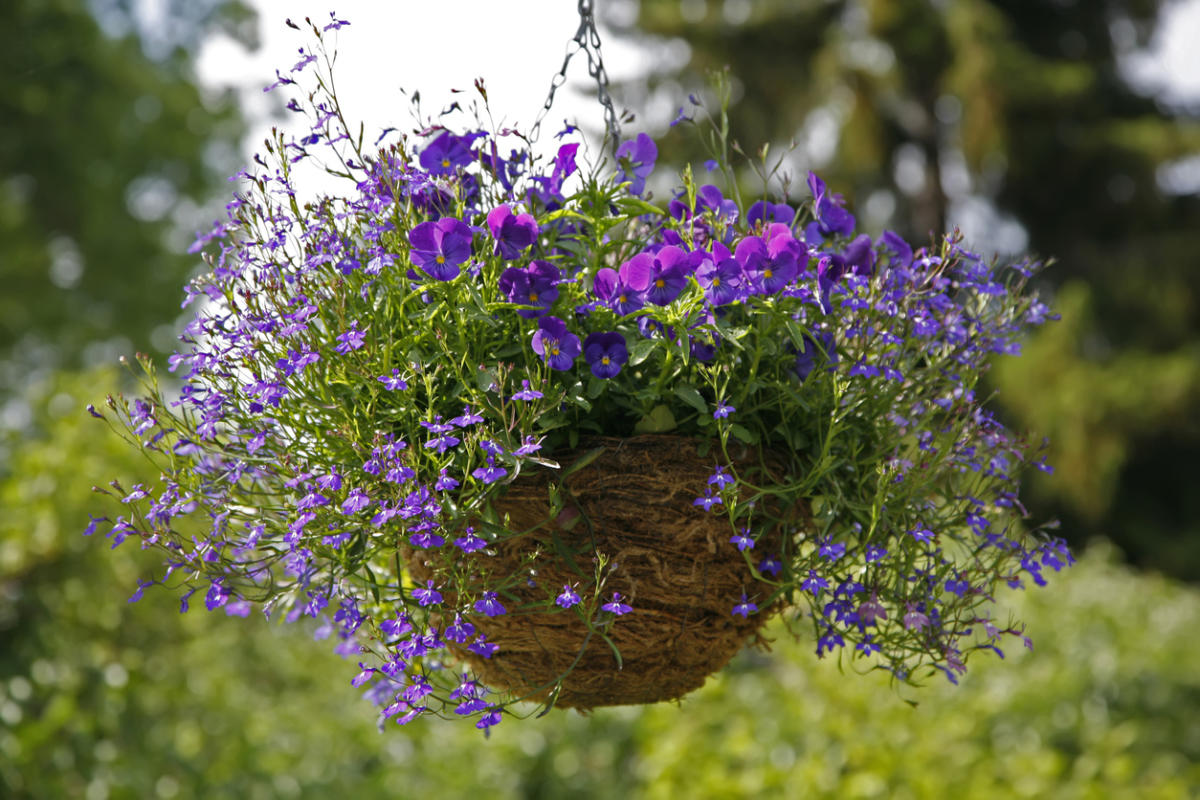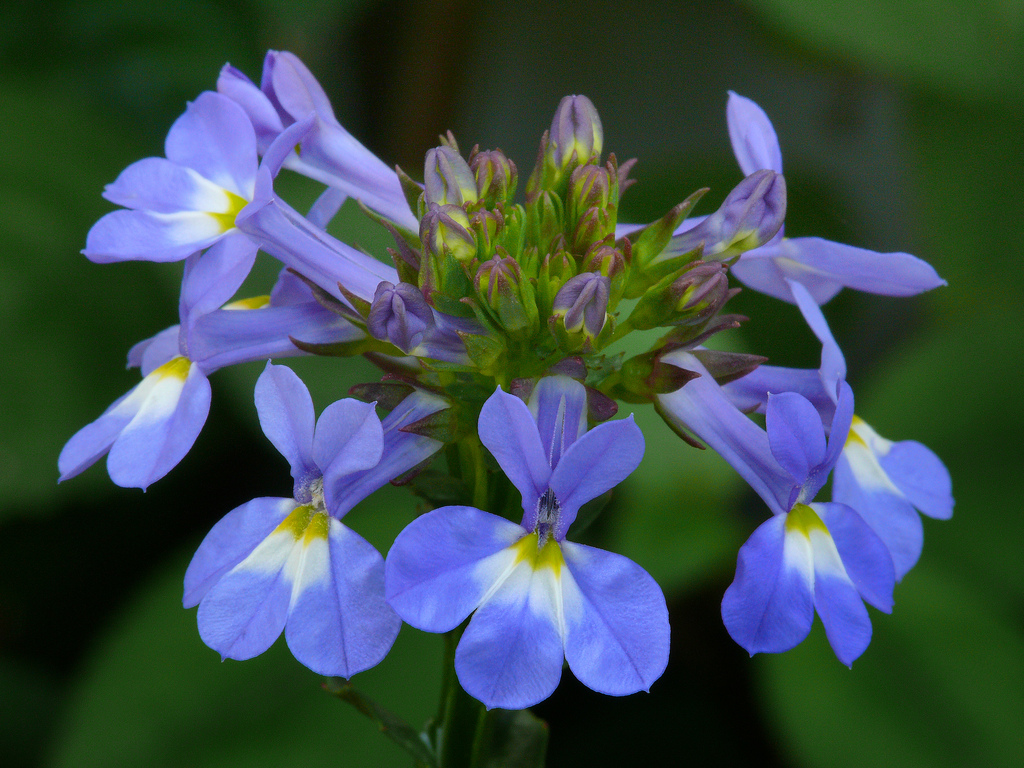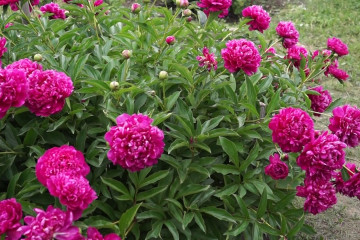Lobelia planting and care in the garden
Content:
Delicate bluish, white or pink, crimson flowers are all lobelia, planting and caring for which usually does not cause difficulties even for beginners. The plant attracts gardeners with abundant flowering, the ability to grow not only in flower beds, but also in balcony boxes, as well as a variety of habitus.
Botanical description
These are herbaceous perennials or annuals. Lobelia bush or trees are less common.
Lobelia (Lobelia) belongs to the numerous family Campanulaceae, or Bellflower. In floriculture, the most common among several hundred species is the lobelia erinus, or black (Lobelia erinus).
The genus was named in honor of the botanist from Flemish Mathias de L'Obel, who first described it. The natural habitat is regions with temperate and tropical climates: America, Australia, Asia and Africa. On the territory of Russia, there are several types: sessile lobelia and Dortman lobelia.
Specifications:
- The plant has thin, branched or straight, densely leafy stems.
- The root system is underdeveloped.
- Leaves are small, oval, alternate, with a jagged border.
- Flowers are small, bell-shaped, located on short pedicels, are collected in apical racemose inflorescences or axillary brushes.
The color of the flowers is white, bluish, crimson, purple. The flowers give off a delicate scent that attracts pollinating insects. The flowering period lasts from June to August. The fruits are capsules with a large number of small brown seeds.
Classification of species
Lobelia is a perennial, but in culture it is often grown as an annual. There are many types, the most common of which are:
- Cardinal lobelia - used as an aquarium plant, it has bright scarlet flowers blooming above the surface of the water.
- Garden - quickly blossoms in early summer and decorates gardens with bright blue lush caps of inflorescences until late autumn. There are ampelous, climbing, bush varieties.
In temperate climates, ampelous lobelia (L. Richardii), black lobelia (L. Erinus), strong (L. Valida), thinnest (L. Tenuior) are most often planted as an annual crop.
Among the perennial species in the gardens there are lobelia:
- beautiful (L. X Speciosa);
- fiery (L. Fulgens Willd);
- Gerardi (L. X Gerardii);
- purple (L. cardinalis).
The cultivars and varieties that are most successful gardeners
Gardeners prefer to decorate their plots with the varieties presented below.

Lobelia, the cultivation of which is first carried out for seedlings, then transferred to open ground
- Lobelia brilliant (Lobelia fulgens)
An ornamental culture with long erect shoots, the height of which reaches 70 cm. The leaf plates are narrow, the flowers are large, collected in cluster inflorescences. Their color is red.
- Lobelia Dortmanna
In nature, the variety is on the verge of extinction.It is found near rivers and lakes, sometimes grows in shallow waters.
- Lobelia Gerardii
A tall specimen reaching 1.2 m in height. It has bell-shaped flowers of lilac and purple hues. The most popular variety of Gherardi lobelia is Vedrariensis.
- Lobelia purple (Lobelia cardinalis)
Differs in strong shoots, towering 1 m above the ground. Inflorescences are original, sultanoid or spike-shaped. Emerald foliage.
Lobelia, whose flowers are scarlet, can be grown as a perennial. She feels good near water bodies.
- Lobelia blue (Lobelia siphilitica)
Perennial with purple or bluish flowers, collected in spike-shaped inflorescences. It is a tall shrub with straight shoots. Often used to breed hybrid varieties.
- Lobelia sessile
In its natural habitat, it lives in the Far East and Siberia. It is a poisonous plant. Reaches a height of 1 m. Shoots are straight and thin, the leaves are elongated, lanceolate, with a serrated edge.
The flowers are distinguished by a pale blue tint. Flowering becomes especially plentiful at the end of summer.
- Lobelia erinus
Herbaceous variety with flexible shoots and oblong-rounded leaves. It is considered the most common among all lobelias grown in flower beds. The flowers are modest in size, up to 2 cm in diameter. The color is most often white or blue. Blooms profusely from June to September. There are columnar, creeping and compact forms.
- Lobelia valida
A low plant up to 40 cm in height, growing in the form of a spreading bush. Its foliage and shoots are painted in a juicy green hue, and the flowers are pink, purple or lilac with a white eye.
- Lobelia tenuior
Graceful, profusely blooming lobelia, its flower blooms on a refined shoot. A wonderful inhabitant of flower beds and mixborders, pots. Forms many lilac, cornflower-blue or pinkish buds. The variety is grown as an annual.
How lobelia propagates by seeds
The most common breeding method is seed. It is recommended to grow lobelia in a seedling way, since the seedlings are very fragile and develop slowly. Self-seeding is also characteristic of the flower.
Growing from seeds
Novice gardeners should know a few tricks of sowing lobelia seeds for seedlings. Being unpretentious in adulthood, it requires painstaking care.
The recommended sowing period is from February to April. Plants planted in January require additional lighting.
As a landing container, you can take:
- peat tablets;
- seedling cassettes;
- disposable cups;
- plastic packaging for food, such as yoghurt.
The container must have drainage holes.
The culture prefers loose, non-acidic soils. For planting lobelia, soil can be purchased in stores or prepared independently from:
- sand;
- turf land;
- humus.
The soil is steamed or calcined in the oven, treated with a weak solution of potassium permanganate.
Since the seeds are very small, they are mixed with sand for planting and poured onto the surface of the soil. Another way is to use peat tablets. They are soaked in water, after which depressions are made and several seeds are placed inside.
Seedling care
The container with crops is covered with glass, kept in a bright and warm place at a temperature of +18 to +22 ° C. Ventilation is carried out regularly to protect against fungus. Seedlings appear in 7 days.
The seedlings are very fragile.How lobelia is taken care of:
- carefully poured from a syringe;
- open the glass daily, gradually increasing the ventilation time;
- protect from drafts;
- highlight;
- thin out the sprouts that have reached a height of 2 cm with tweezers.
Dive and transfer
The pick is carried out 30 days after the emergence of shoots. This is done with a spoon, separating some of the sprouts and transferring them to a large container. After this procedure, the seedlings are kept in a shaded place for 2 days.
Well-lit or slightly shaded areas with light and loose sandy or loamy soils are suitable for transplanting into open ground.
How is the transplant carried out:
- Planting pits are prepared with a depth of about 20 cm, at a distance of 15 cm from each other.
- Drainage is poured to the bottom.
- 3-4 seedlings with an earthen clod are placed in each hole.
- Carefully sprinkle with earth.
Planting cuttings
Reproduction by cuttings is resorted to when it becomes necessary to preserve the characteristics of the mother plant. To do this, perform the following actions:
- In autumn, healthy perennials are selected, transplanted into pots.
- Transferred to a greenhouse or residential area.
- Water it during the winter.
- Cuttings are cut in the spring. The length is about 10 cm.
- They are placed in water with the addition of a root former.
- Then they are transplanted into separate small containers, for example, disposable cups.
Dividing the bush
This method is rarely practiced. With the onset of spring, when the first shoots are formed, lobelia bushes are dug up and divided into parts, after which they are seated in pre-prepared holes.
Features of care in the garden
Caring for lobelia outdoors or in balcony boxes is straightforward.
Suitable conditions
Lobelia are light-loving, cold-resistant, moisture-loving plants. They grow well in sunny areas with sufficient moisture, nutritious soil without excess organic fertilizers.
What is the plant afraid of
The culture does not tolerate an abundance of rain, therefore, when watering, the amount of atmospheric precipitation is taken into account. At the same time, dry periods negatively affect the condition of the flower.
Watering
The root system is not located at the soil surface, but deepens vertically, by 10-15 cm. For this reason, the plant does not impose special requirements for watering. It is enough to moisten the soil to the indicated depth and make sure that it does not dry out.
Mulching
When grown in open ground, ampelous lobelia varieties, the soil can be mulched with a hydrogel so that it retains moisture.
Loosening
Loosening allows you to eliminate the surface crust on the ground, to ensure the flow of air and prevent the outflow of moisture.
Top dressing
Novice growers are wondering how to feed lobelia for abundant flowering. Vermicompost rich in phosphorus and potassium is considered the best remedy. One plant needs about 150 g per season. This amount is divided into 3 parts and applied during the season:
- the first - 7 days after the transfer of seedlings to open ground;
- the second - before flowering;
- the third - after the first flowering and pruning.
Pruning
Pruning helps to awaken the dormant buds and make the shrub more lush. This operation can be performed several times in one summer. It is recommended to cut the growth point, at a height of up to 10 cm.
Transfer
The transplant is carried out in the fall. For wintering, they are transferred to home conditions in pots. In countries with warm climates, flowers can remain outdoors in winter.
When and how it blooms
The first inflorescences appear on young bushes 8-10 weeks after sowing the seeds. They open up in large quantities at once.
- Flower shapes. Corollas of flowers are zygomorphic, often similar to bells. Their size is from 1 to 2 cm. The difference lies in the fact that in lobelia the tube is cut lengthwise and displaces the teeth of the corolla upward.The ovaries are always two-celled.
- Flowering period. The entire flowering period of lobelias includes several waves with a small interval. They last from May to September, after which seed pods are formed.
- Changes in care during flowering. The main rule of caring for flowering specimens is to apply dressings with a minimum nitrogen content, which interferes with the formation of inflorescences. Fertilizers should be rich in potassium and phosphorus, which promote abundant and long-lasting flowering.
Preparation of perennial lobelias for wintering
The culture does not belong to the number of winter-hardy, the cold threatens its death. For this reason, for the winter, perennial varieties are transplanted into containers and placed in a living room or on a terrace or balcony. The temperature in these rooms should not fall below +5 ° С.
Lobelia seeds are harvested in the fall, before a cold snap. To do this, cut the bushes, lay out a sheet of paper and shake the plant over it. The seeds are crumbling.

The paper is folded into bags and the date of collection and the name of the variety are indicated on them
Possible growing problems
Crop maintenance problems are most often caused by improper care and insect attacks.
- Pests
The main threats to lobelia are aphids, scale insects and slugs. To combat them, insecticides are used, and not only chemical agents, but also traps help to get rid of slugs.
- Diseases
Common diseases are root rot, powdery mildew, rust and mottling. Treatment consists of fungicide treatment.
The most dangerous for lobelia is mosaic, fungal infection. Its signs are crimson and brown spots on the leaf plates.
- Signs of improper care
The appearance of plants allows you to determine how comfortable conditions are created for it. If the stems turn gray, mold appears, this indicates foliar watering, which must be avoided. If the flowers begin to dry out by the end of summer, this is a sign of nutrient deficiency and the need for pruning.
With the help of lobelia, designers create beautiful flower borders and "carpets", alpine slides. Suitable neighbors for culture are nasturtiums, marigolds, alissum, petunias, pelargoniums. For planting lobelias in pots and balcony boxes, for decorating terraces and verandas, ampel varieties are used. They bloom throughout the summer.



















